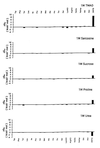Osmolyte-driven contraction of a random coil protein
- PMID: 9689069
- PMCID: PMC21327
- DOI: 10.1073/pnas.95.16.9268
Osmolyte-driven contraction of a random coil protein
Abstract
The Stokes radius characteristics of reduced and carboxamidated ribonuclease A (RCAM RNase) were determined for transfer of this "random coil" protein from water to 1 M concentrations of the naturally occurring protecting osmolytes trimethylamine N-oxide, sarcosine, sucrose, and proline and the nonprotecting osmolyte urea. The denatured ensemble of RCAM RNase expands in urea and contracts in protecting osmolytes to extents proportional to the transfer Gibbs energy of the protein from water to osmolyte. This proportionality suggests that the sum of the transfer Gibbs energies of individual parts of the protein is responsible for the dimensional changes in the denatured ensemble. The dominant term in the transfer Gibbs energy of RCAM RNase from water to protecting osmolytes is the unfavorable interaction of the osmolyte with the peptide backbone, whereas the favorable interaction of urea with the backbone dominates in RCAM RNase transfer to urea. The side chains collectively favor transfer to the osmolytes, with some protecting osmolytes solubilizing hydrophobic side chains as well as urea does, a result suggesting there is nothing special about the ability of urea to solubilize hydrophobic groups. Protecting osmolytes stabilize proteins by raising the chemical potential of the denatured ensemble, and the uniform thermodynamic force acting on the peptide backbone causes the collateral effect of contracting the denatured ensemble. The contraction decreases the conformational entropy of the denatured state while increasing the density of hydrophobic groups, two effects that also contribute to the ability of protecting osmolytes to force proteins to fold.
Figures




Similar articles
-
The peptide backbone plays a dominant role in protein stabilization by naturally occurring osmolytes.Biochemistry. 1995 Oct 3;34(39):12884-91. doi: 10.1021/bi00039a051. Biochemistry. 1995. PMID: 7548045
-
Osmolyte-induced protein folding free energy changes.Proteins. 2006 May 1;63(2):290-6. doi: 10.1002/prot.20868. Proteins. 2006. PMID: 16453342
-
Hydrogen bonding progressively strengthens upon transfer of the protein urea-denatured state to water and protecting osmolytes.Biochemistry. 2010 Feb 16;49(6):1310-8. doi: 10.1021/bi9015499. Biochemistry. 2010. PMID: 20073511 Free PMC article.
-
The osmophobic effect: natural selection of a thermodynamic force in protein folding.J Mol Biol. 2001 Jul 27;310(5):955-63. doi: 10.1006/jmbi.2001.4819. J Mol Biol. 2001. PMID: 11502004 Review.
-
Protecting thermodynamic stability of protein: The basic paradigm against stress and unfolded protein response by osmolytes.Int J Biol Macromol. 2021 Apr 30;177:229-240. doi: 10.1016/j.ijbiomac.2021.02.102. Epub 2021 Feb 16. Int J Biol Macromol. 2021. PMID: 33607142 Review.
Cited by
-
Molecular mechanism for the preferential exclusion of TMAO from protein surfaces.J Phys Chem B. 2012 Oct 11;116(40):12095-104. doi: 10.1021/jp304298c. Epub 2012 Oct 1. J Phys Chem B. 2012. PMID: 22970901 Free PMC article.
-
The effect of some osmolytes on the activity and stability of mushroom tyrosinase.J Biosci. 2006 Sep;31(3):355-62. doi: 10.1007/BF02704108. J Biosci. 2006. PMID: 17006018
-
Osmolyte effects on protein stability and solubility: a balancing act between backbone and side-chains.Biophys Chem. 2011 Nov;159(1):90-9. doi: 10.1016/j.bpc.2011.05.012. Epub 2011 May 19. Biophys Chem. 2011. PMID: 21683504 Free PMC article.
-
Thiamine diphosphate binds to intermediates in the assembly of adenovirus fiber knob trimers in Escherichia coli.Protein Sci. 2007 Dec;16(12):2684-93. doi: 10.1110/ps.072805007. Epub 2007 Oct 26. Protein Sci. 2007. PMID: 17965194 Free PMC article.
-
Osmolyte-induced conformational changes in the Hsp90 molecular chaperone.Protein Sci. 2010 Jan;19(1):57-65. doi: 10.1002/pro.282. Protein Sci. 2010. PMID: 19890989 Free PMC article.
References
-
- Yancey P H, Clark M E, Hand S C, Bowlus R D, Somero G N. Science. 1982;217:1214–1222. - PubMed
-
- Arakawa T, Bhat R, Timasheff S. Biochemistry. 1990;29:1914–1923. - PubMed
-
- Liu Y, Bolen D W. Biochemistry. 1995;34:12884–12891. - PubMed
-
- Wang A, Bolen D W. Biochemistry. 1997;36:9101–9108. - PubMed
-
- Harrington W F, Schellman J A. C R Trav Lab Carlsburg, Ser Chim. 1956;30:21–43. - PubMed
Publication types
MeSH terms
Substances
Grants and funding
LinkOut - more resources
Full Text Sources

